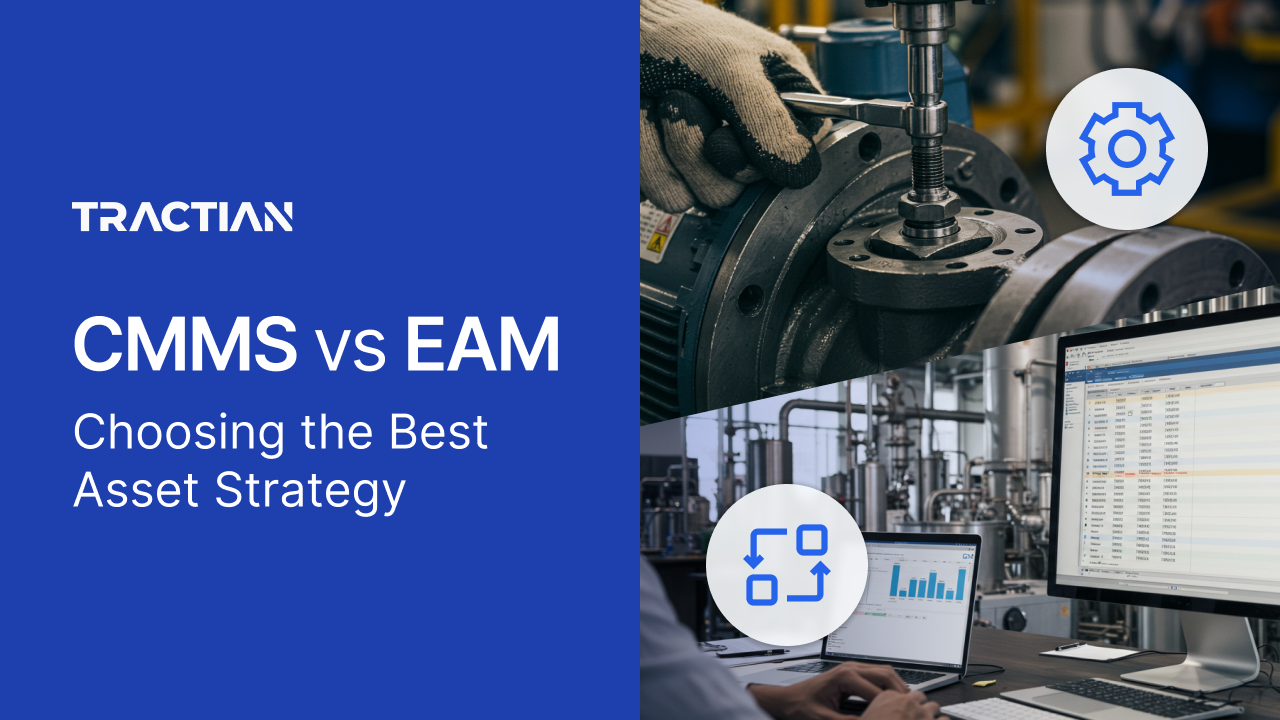When it comes to choosing software systems to manage industrial assets, there are two that consistently dominate the conversation: the CMMS (Computerized Maintenance Management System) and the EAM (Enterprise Asset Management) systems. But the considerations about each isn’t which one is better than the other. No, it’s which one solves the particular problem sets you’re facing.
What’s actually happening on the plant floor should determine whether a CMMS or an EAM is best for you. Both systems aim to improve asset reliability, reduce downtime, and centralize maintenance operations.
But this is where the similarities end. Understanding how each system operates, and where each one excels, is essential for teams that want to stop solving breakdowns reactively through firefights. It’s the first proactive step to gaining strategic asset control on the plant floor.
In this article we’ll show you what truly sets EAM and CMMS apart, and help you know which is the best option for your plant.
What Is EAM?
EAM stands for Enterprise Asset Management. What it brings to the table is full-spectrum control over an asset’s entire lifecycle, starting from the moment it's specified for purchase to the day it’s decommissioned.
Unlike maintenance-specific tools, an EAM isn’t just focused on repairs or upkeep. It goes upstream and downstream, covering procurement, installation, performance monitoring, compliance, and eventual disposal.
This broader scope makes it a strategic option for organizations managing complex, high-value asset infrastructures.
Think of it this way: while a CMMS helps ensure a pump gets lubricated on time, an EAM ensures the right pump was selected, properly installed, consistently maintained, and efficiently replaced when it reaches the end of its life.
It connects maintenance history with purchasing data, risk assessments, depreciation schedules, and regulatory requirements. That means every decision, from repair to replacement, comes with context.
When used well, EAM systems help organizations:
- Extend asset lifespan with strategic planning.
- Ensure compliance from installation through retirement.
- Align maintenance with procurement and financial goals.
What Is a CMMS Software?
While EAM takes a big-picture view, a CMMS (Computerized Maintenance Management System) focuses on the day-to-day mechanics of keeping your operation running.
If EAM encompasses the full asset lifecycle, CMMS serves as the control tower for all maintenance activities. It’s built to centralize, organize, and automate all the tasks that keep equipment reliable and downtime at bay.
A modern CMMS replaces guesswork with structured workflows, from scheduling preventive maintenance and assigning work orders to tracking execution and logging parts usage. Every task is documented, time-stamped, and linked to asset history. No more need for sticky notes, whiteboards, or fragmented spreadsheets.
In practical terms, CMMS software helps maintenance teams:
- Create and manage PM schedules based on time, usage, or condition.
- Dispatch work orders with step-by-step instructions and asset data.
- Track technician activity, parts consumption, and completion status.
- Analyze performance trends to reduce unplanned downtime.
A CMMS is maintenance made visible and manageable. It turns what used to be reactive fire drills into proactive, repeatable processes.
And when done right, a CMMS doesn’t just keep assets running. It boosts wrench time, improves team efficiency, and feeds the metrics that matter most: uptime, response time, backlog, and cost per repair.
Key Differences Between EAM and CMMS
When it comes to managing industrial assets, EAM and CMMS aren’t interchangeable. They’re designed for different scopes, teams, and maturity levels. Understanding where they diverge is crucial for selecting the right system for your operation.
While an EAM system supports the entire asset lifecycle (design, procurement, operation, and decommissioning), a CMMS focuses on keeping your machines running efficiently and your maintenance team ahead of failures.
To put it simply:
- EAM is the strategist: looking across departments, budgets, and long-term planning.
- CMMS is the tactician: focused on daily execution, technician workflows, and work order control.

This breakdown isn’t about picking a winner. It’s about identifying what your operation actually needs. Are you building a maintenance strategy for enterprise-wide asset control, or do you need to get your maintenance routines under control first?
When Should You Choose EAM Over CMMS?
If your operation extends beyond day-to-day maintenance and demands visibility across the full asset lifecycle, EAM is your playbook.
Enterprise Asset Management systems are built for scale. They’re designed for manufacturers, utilities, and capital-intensive industries where asset decisions impact everything from procurement and compliance to budgeting and operational strategy.
EAM isn’t just about fixing things when they fail. It’s about orchestrating every phase of asset performance across sites, systems, and departments. That’s what makes it indispensable for teams dealing with long asset lifespans, multiple stakeholders, and high compliance standards.
When does EAM make sense?
- You manage large fleets or complex infrastructure.
- You need visibility into asset health, cost, and performance from installation to end-of-life.
- You want to integrate inventory management, procurement, and depreciation tracking into one system.
- You operate in a heavily regulated environment where safety and compliance must be documented and traceable.
- You’re advancing toward Industry 4.0, and want your systems to match the complexity of your operations.
And here’s something that often surprises people: EAMs aren’t just for massive enterprises anymore. In fact, recent studies show that adoption is accelerating even faster among small and mid-sized organizations than among large corporations. As AI and cloud-based tools become more accessible, teams of all sizes are turning to enterprise CMMS software as a bridge to full lifecycle visibility and tighter operational control.
The Advantages of CMMS in Asset Management
If you’re aiming to strengthen your maintenance program without overhauling your entire asset infrastructure, CMMS is where you start. It brings structure, clarity, and consistency to what is often the most chaotic part of operations: maintenance.
For many organizations, a CMMS is the fastest way to reduce downtime, cut reactive activities, and ensure preventive maintenance works as expected. It’s not about complexity, but about control.
The following are what makes CMMS indispensable:
Centralized Maintenance Intelligence
Everything your team needs is all in one place. This applies to asset specs, maintenance histories, manuals, SOPs, part lists, and more. That means less time searching, fewer errors, and better handoffs between shifts and teams.
Everyone, from techs to supervisors, works from the same source of truth.
Predictive, Preventive, Precise
A CMMS turns reactive maintenance into a planned, data-driven routine. It uses asset history, usage metrics, and condition data to forecast repair needs, schedule PMs, and avoid downtime before it happens.
According to the U.S. Department of Energy, a preventive maintenance approach supported by tools like CMMS can reduce energy use by 18%, compared to reactive models that can waste up to 60%.
That’s efficiency you can measure, not just in energy, but in time, labor, and asset lifespan.
Operational Impact Where It Matters
When implemented right, CMMS drives tangible results:
- Fewer unplanned breakdowns
- Lower emergency maintenance costs
- Higher wrench time and technician efficiency
- Improved safety compliance
- Extended asset life and lower replacement rates
And the numbers back it up. Research by Aberdeen Group shows that CMMS implementation can improve maintenance efficiency by up to 20%.

Case Studies: What Integration Looks Like in Action
It’s one thing to talk about EAM and CMMS integration. But it’s another to see how it transforms operations on the ground. Two standout examples come from teams that have redefined asset reliability through the use of smarter maintenance systems.
At Ahlstrom-Munksjö, a global leader in fiber-based materials, the maintenance team faced mounting downtime risks across their critical assets.
By adopting a system that combined real-time condition monitoring with structured maintenance workflows, they shifted from reactive firefighting to proactive control. This resulted in predictive visibility into failures and a sharp drop in emergency interventions. Read the full case study.
Over at Embraer, one of the world’s top aircraft manufacturers, asset availability was more than a KPI. Its status was raised to a safety and performance mandate. Their team integrated maintenance intelligence with broader asset lifecycle strategies, creating a feedback loop between CMMS operations and EAM-level planning.
The outcome was a significantly improved Mean Time Between Failures (MTBF) and streamlined decision-making across maintenance, operations, and procurement. Explore the Embraer story.
CMMS or EAM?
It’s worth mentioning again that choosing between CMMS and EAM isn’t about picking a winner. The reality is you must identify the system that fits your operation’s complexity, scale, and strategic goals.
If you need to increase efficiency, reduce downtime, and bring order to daily maintenance, a CMMS is the most effective way to do it. It centralizes your routines, eliminates guesswork, and gives your team the structure and insights to perform at their best.
And if you're managing complex operations where asset decisions impact procurement, budgeting, or capital planning, traditional EAMs have long been the go-to. However, they come with trade-offs: lengthy implementations, rigid workflows, and extensive customization.
This is precisely where Tractian breaks the standard mold. It delivers the lifecycle intelligence of an EAM, with the usability and speed of a CMMS. From day one, your team gets total visibility, smarter automation, and data that drives action.
Tractian provides your team with total visibility into every task, every asset, and every shift, all while making the work simpler, faster, and smarter. It replaces whiteboards, spreadsheets, and gut guesses with real control and real results.
And it’s not another complex system that takes months to set up. In a matter of weeks, which includes a free onboarding process, you'll have results.
Common FAQ for CMMS vs EAM
What is the main difference between a CMMS and an EAM system?
A CMMS focuses on day-to-day maintenance operations like work orders, preventive maintenance, and technician tracking. An EAM covers the entire asset lifecycle, including procurement, compliance, and decommissioning.
Can a small business benefit from an EAM system?
Yes. While traditionally built for large enterprises, modern EAM tools, especially cloud-based ones are now accessible to small and mid-sized businesses.
Is CMMS software enough for managing assets long term?
It depends on your goals. A CMMS is ideal for controlling maintenance operations and reducing downtime. But if you need asset lifecycle visibility and integration with procurement or financial planning, an EAM may be a better fit.
Can CMMS and EAM systems work together?
Yes. Some platforms combine CMMS capabilities with EAM features, giving teams real-time maintenance control while supporting long-term asset planning. Tractian is a good example of this hybrid approach.
How do I know which system is right for my team?
Start by evaluating your current needs. If your focus is on organizing work orders and improving uptime, a CMMS is the best first step. If you’re managing capital assets across multiple departments with financial, compliance, or inventory requirements, an EAM is likely the better fit.



